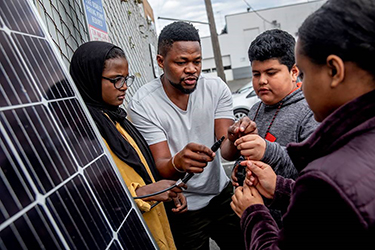|
Subscribe / Renew |
|
|
Contact Us |
|
| ► Subscribe to our Free Weekly Newsletter | |
| home | Welcome, sign in or click here to subscribe. | login |
Construction
| |
 |
September 30, 2021
Strategic energy planning for equity and resilience
Sazan Environmental Services

Newman
|
While K-12 schools account for less than 1% of the nation’s greenhouse gas emissions, they present a transformational role in advancing the clean energy economy, through direct investments in electrification, renewable energy and education.
Developing a strategic energy plan can guide K-12 schools through implementation strategies for energy-efficiency measures and renewable energy, while responding to goals identified by key stakeholders and the broader community. Based on early engagement with facilities maintenance staff, utility representatives, teachers and students, paired with a thorough review of school policies and board resolutions, a clean energy strategy can also serve as an implementation framework for valuable new funding resources, energy grants and incentives.
STAKEHOLDER ENGAGEMENT
Imagine a school campus free of diesel emissions from buses, limiting harmful exposure to air pollutants and strengthening students’ academic performance. Bus electrification is just one of the many upcoming changes anticipated for K-12 schools across the country aimed at reducing reliance on combustion-based engines for the nation’s 500,000 school buses.
Will this opportunity for electromobility take precedent over heating system conversion, lighting retrofits, or solar photovoltaic (PV) installations with energy monitoring dashboards for student education? A strategic energy plan driven by key stakeholders’ vision statement, developed in support of established performance metrics and goals, can be the roadmap for prioritizing energy upgrades.
The Washington State Energy Strategy convened a task force of industry exports with targeted outreach to traditionally underserved communities and vulnerable populations, resulting in aggressive replacement goals of short-haul vehicle classes (like school buses) with electric vehicles. This intentional engagement at the outset of the strategic planning process enabled a more-diverse set of evaluation metrics to determine “what success looks like” for everyone in our growing communities. With equity, social and environmental justice outcomes informed by an engagement process designed to reduce implicit bias of decision-makers, a strategic energy plan can help “the transition to an equitable clean energy future,” as described by Washington state’s new strategy.
As new approaches for community engagement garner more inclusive results, K-12 schools are well underway with clean energy implementation. As of April, 7,332 K-12 schools in America use solar power, with 5.3 million students attending schools with a solar PV installation. In Seattle, approximately 800 kilowatts of solar PV capacity is installed across Seattle Public Schools, providing energy cost savings and opportunities for student education.
CLEAN ENERGY LABORATORY
The strategic energy planning process also builds relationships with potential partners, such as Bonneville Environmental Foundation’s Clean Energy Bright Futures Program, the Sustainability Ambassadors, and existing student coalitions. Including educational outcomes in energy plans can accelerate connections between demonstration projects and opportunities for career-connected learning. Student participation in project planning, implementation, measurement and evaluation can provide technical skills and important insight into potential career pathways after graduation.
Using peer-to-peer education tactics demonstrated by the Sustainability Ambassadors program, K-12 students have been successful in obtaining internship roles at leading solar contractors and other clean energy industry firms. This strategy is of particular interest for Washington-based clean energy firm Sphere Solar Energy, whose mission to engage BIPOC students to accelerate career connections in the energy industry has been recognized by the Seattle Office of Economic Development (OED). As a recipient of the Seattle OED Career Connected Learning grant, Sphere developed a clean energy program plan in partnership with educators, students and industry professionals.
The strategic energy planning process also aligns with important grant funding requirements, such as the Washington Department of Commerce Clean Energy Fund grants, to verify energy performance for a set period after grants are awarded and equipment is installed. Using the Department of Energy’s Strategic Energy Planning process is a proven framework for aligning goals with projects and funding streams for implementation.
A coordinated asset management approach for strategic clean energy investments can also prioritize efficiency, conservation, renewables and resiliency measures to meet new requirements, such as the Clean Buildings Act in Washington. Utility engagement on Clean Buildings Act compliance ties into Early Adaptor Incentives, as well as alignment with current and future energy performance targets under the new Washington State Energy Code (2018) and Clean Energy Transformation Act. Developing a clean energy task force is an important strategy to prepare and finalize strategic plans, resolutions, and cyclical renewal schedules for critical school infrastructure.
At the nexus of climate adaptation and COVID-19 response, a new wave of funding resources is anticipated to achieve healthy building powered by clean energy. Training students and the broader K-12 community to participate as co-leaders in this process can help shape a more equitable clean energy industry. Demonstration projects, like Snohomish County PUD’s Arlington Microgrid, shed light on the potential for battery electric buses to power the grid during an earthquake. A recent series of grant awards for Grid Modernization projects includes several school districts on similar electric bus initiatives.
Through careful and engaged strategic energy plan development, K-12 schools can achieve measurable success on clean energy investments while advancing goals that strengthen community resilience and career-connected learning opportunities for students.
Jack Newman is director of Clean Energy Solutions at Sazan Environmental Services and serves as board president at Solar Washington, a nonprofit organization committed to advancing Washington’s solar industry. While K-12 schools account for less than 1% of the nation’s greenhouse gas emissions, they present a transformational role in advancing the clean energy economy, through direct investments in electrification, renewable energy and education.
Other Stories:
- Nature and nurture in Renton's Cascade/Benson Hill neighborhood
- Exploring the benefits of mass timber
- School ventilation strategies for a pandemic
- How schools and designers can manage crises
- Effective learning design in the state-of-the-art Honouliuli Middle School
- Providing for diversity in K-12 schools
- Trauma-informed design in schools
- Progressive design-build is changing the future of K-12 construction



